Our
plan for the day was to visit Nandankanan Zoological Park and while returning,
to visit Udaygiri and Khandagiri caves. It dawned to me as well as to our driver in
the morning of our schedule visit that it was Monday and Nandankanan was closed
on Mondays. For the next day, we had planned to leave Bhubaneshwar for Konark
and on the way we were to visit Dhauligiri. With Nandankanan closed
on Monday, we had to change our itinerary substituting Dhauligiri for
Nandankanan which we would have to cover the next day before proceeding to
Konark.
Dhauligiri – Shanti Stupa and Ashoka Rock Edicts
After breakfast, we proceeded first to Dhauligiri which is about 8 kms from
Bhubaneshwar city centre off Bhubaneshwar-Konark road. Being working days,
there was some traffic on the road preventing an uninterrupted drive to
Dhauligiri. Also, the work of upgrading the Konark road to four lanes was also in progress. All these added to some traffic chaos on the Konark road until we took a
diversion to a two lane road to the right for a further 3 kms of drive for
reaching Dhauligiri.
After
climbing some steps to reach on the top of Dhauli hill, there were further
steps to climb to Shanti Stupa ( also called Peace Pagoda). The whole
complex is so peaceful and serene that one cannot imagine that the bloody
Kalinga war was fought on the banks of Daya
river flowing below the complex. Now, not only a Peace Pagoda here, one
can have a spectacular view of Daya river from Shanti Stupa flanked by farms on both sides of the river.
The
Shanti Stupa was constructed by Japanese Buddha Sangh in 1972 as a symbol of
peace and non-violence. It was here that Emperor Ashoka, after the bloody Kalinga war, laid down arms and accepted the principle of non-violence as taught by Buddhism.
The Stupa has four idols of Gautam
Buddha facing the four directions in different poses. There are also some
motifs on the stone panels on the walls of Stupa.
At
the base of the Dhauligiri, there are shops of curios, dry fruits and spices. We found that dry fruits and spices were
sold here much below the market prices. These appear to be of rejected
qualities at the factory and sold here in sealed plastic covers preventing the checking of the contents. The tourists
should be circumspect about the quality of dry fruits and spices sold here.
While
returning from Shanti Stupa, we stopped for some time to see Ashoka Rock Edict
which is about one km before Shanti Stupa. Presently, this giant rock edict is
protected from the top by a cemented slab and covered on its three sides by fixed
glass panels. So inscriptions on the rock can be seen only through the glass.
Some pictures taken at Dhauligiri with captions are uploaded below:
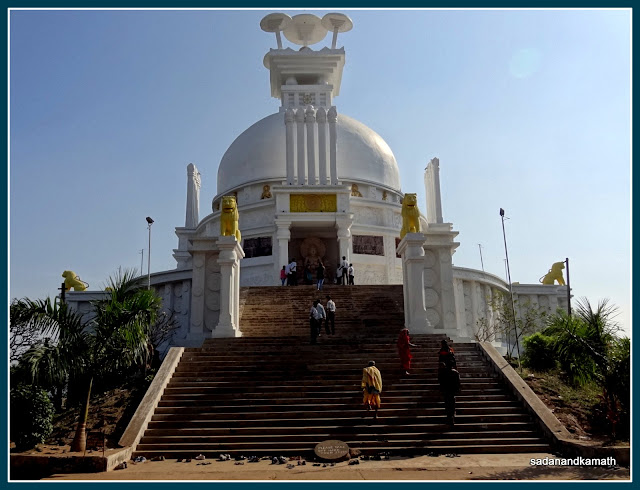 |
| Shanti Stupa at Dhauligiri which is
about 8 kms from Bhubaneshwar city centre off the road to Puri-Konark |
 |
| Shanti Stupa has four Buddha statues in
different poses facing four directions. This one is facing the stone
staircase leading to the Stupa. |
Standing Buddha in Shanti Stupa
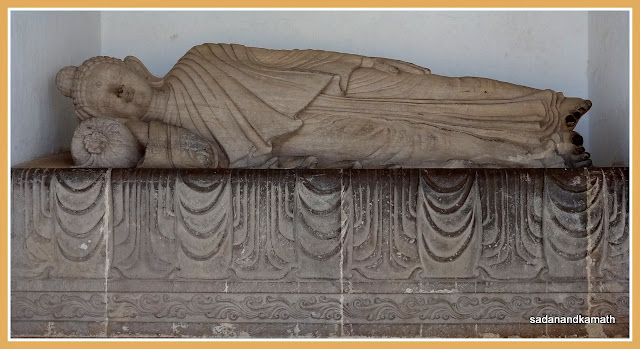 Reclining Buddha in Shanti Stupa
Reclining Buddha in Shanti Stupa
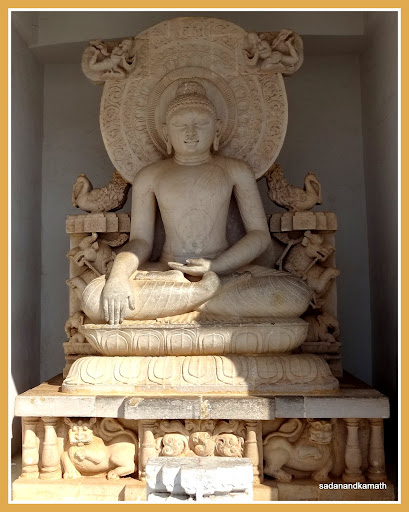 |
| Sitting Buddha in Shanti Stupa |
 |
| View from Shanti Stupa Dhauli. The river
in the middle is called Daya river. It is said that during the Kalinga war, the
colour of this river turned red due to blood of the many dead persons. With
this the realisation came to King Ashoka about the magnitude of horror
came with a war. |
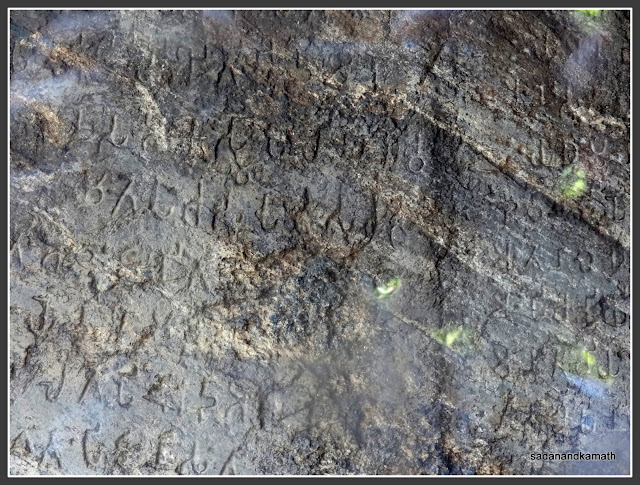 |
| Rock edict of King Ashok on the side of the road to Dhauligiri. This rock inscriptions belong to about 250 B.C. and are about the principles of Buddhism of peace and non-violence. |
Udaygiri-Khandagiri
Caves
From
Dhauligiri, which is located south-west of Bhubaneshwar, we had to travel about
15 kms to the north-west to reach Udaygiri-Khandagiri caves. Both these caves
hills are located opposite to each other bisected by NH-5 though the entry to
both these cave hills is through a town road off NH-5. Both these caves are
maintained by ASI and there is a entry fee of Rs.5/- per head for Indians and
citizens of SAARC countries and Rs.100/- per head for foreigners. Entry for
children below 15 years is free.
As
soon as we entered Udaygiri cave complex, we were greeted by a group of
langoors. Surprisingly, they were docile and did not bothered the visitors.
There are 18 caves in the complex
located on a hill but for those who are short of time, caves like Ranigumpha,
Hathigumpha, Ganeshgumpha are worth spending some time. While Hathigumpha and
Ganeshgumpha do not have many carvings, they are important for rock
inscriptions. Ranigumpha is the only
group of caves which are double story structure and the largest among other cluster
of caves with intricate carvings on the top of the doors of the caves as well
as on the walls. In my view, Ranigumpha is the most impressive cave among the
caves of Udaygiri-Khandagiri cave complexes. Many of the wall carvings have
been damaged probably over a period of time as they are made on sand stones
which are delicate stones. The caves are very simple as these were probably
used as dormitories for Jain bhikshus (monks).
On
the top of Udaygiri hills is the remains of a apsidal ( semi-circular part of the
base of a structure) belonging to C.1st B.C. which was excavated in 1958. Hence, it is assumed that Udaygiri caves may have been constructed during
1st B.C. The apsidal base reminded me of similar type of cave
structure I have seen in Karla Buddhist caves in Lonavala (near Pune). Hence,
this place may have been a prayer hall for Jain monks. From Udaygiri hilltop, Digambar Jain temple on the Khandagiri hills is visible but not the caves underneath
it.
Khandagiri
caves are located on a hill just opposite Udaygiri cave hill across the road.
Unlike Udaygiri caves which can be reached on the stone stairs, Khandagiri caves
and the Jain temple atop can be reached by ascending on a rocky/stony path
after an initial short distance on a stony stairs. Here also, we encountered a big group of langoors at the entrance but they did not trouble us.
Khandagiri caves are simple
and its carvings depict stories of day to day life. On Khandagiri hill top is an
active Digambar Jain temple which was reconstructed sometime in 19th
century. From the hilltop, one can see
the south-east part of Bhubaneshwar city and the airport.
After
the completion of our visits to Udaygiri-Khnadagiri, we took a break for lunch
at Dalma Restaurant to try Odiya thali meals. It was first time for all of us
to taste some Odiya cuisine. We ordered for vegetarian thali meals and liked it
so much that we repeated the same on the
next day on our way to Konark.
After
lunch, we returned to our hotel room around 3.00 p.m. With some afternoon siesta followed by tea, we were ready for some shopping trip in the evening.
Some
pictures taken at Udaygiri-Khandagiri with captions are uploaded below :
 |
| Approach to Udaygiri caves |
 |
| Ranigumpha Cave, Udayagiri |
 |
| Carvings on the door head of one of the
caves of Ranigumpha Cave |
 |
| Ranigumpha caves seen from the roof of the caves. |
 |
| Hathigumpha Cave. This cave has not
much carvings but it has some very old inscriptions
on the rock. |
 |
| On way to the top of the cave hills
there is Baagh cave (left) known as tiger cave (Cave No. 12) due to its
resemblance of tiger's face. |
 |
| On the top of the cave hills lies an
excavated apsidal Jain Shrine believed to be of 2nd Century BC |
 |
| A langoor with her kid in Udaygiri caves |
 |
| Jain temple atop Khandagiri hills seen
from Udaygiri caves. Below the temple on the right side are Khandagiri caves |
 |
| Carvings on the top of a cave door in
Khandagiri caves |
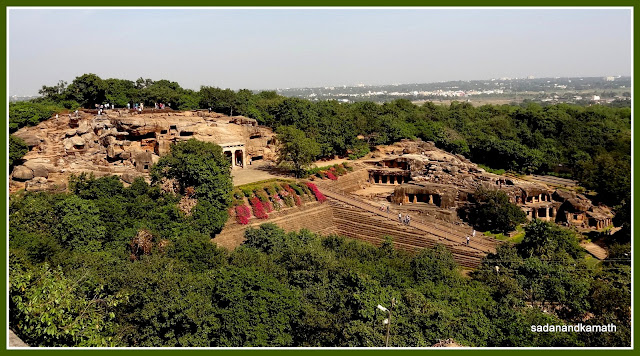 |
| A bird's eye view of Udaygiri caves from Khandagiri
caves. Both these hills are located opposite to each other intersected by a road |
 |
View of Bhubaneshwar city from
Khandagiri caves. Airport runway is in the background.
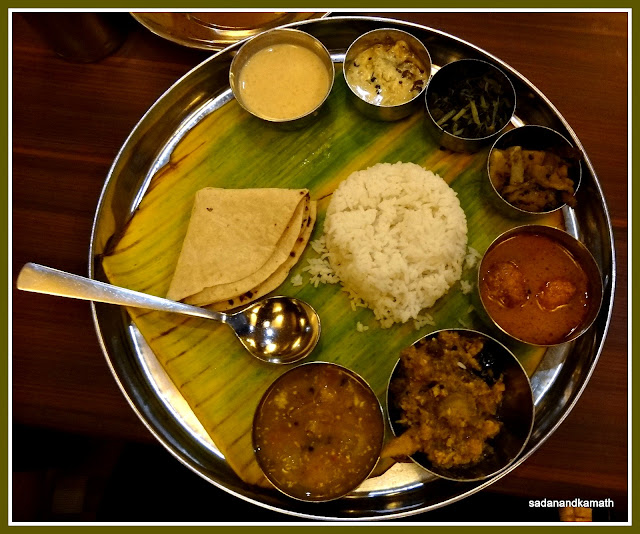 |
A typical vegetarian thali meals with Odiya cuisine in Dalma Restaurant, Bhubaneshwar
Nadankanan Zoo and
Botanical Gardens
In
the previous day, we had arranged for an Innova (instead of Indica) for taking
us to Nadankanan and thereafter to drop at Konark. Next day, after breakfast, we
checked out from the hotel and commenced our trip to Nadankanan at around 9.00
a.m. The 20 kms journey from our hotel took about 30 minutes to reach the
destination. There was a big queue for ticketing as only one counter was
opened. Fortunately, another counter was soon opened and we got the entry
tickets quickly. The entry fee is Rs.20/- per head for Indians and Rs.100/- per
head for foreigners. In addition, there is a camera fee of Rs.10/-. The zoo and
botanical garden are open between 8.00 a.m. and 5.30 p.m. Those who do not wish
to walk can hire the battery operated open van to see the zoo. We decided to
walk and hired a guide (Rs.150/-) available from the pool of guides authorised
by Nandankanan Zoo.
The
Zoo is divided into two parts – animals in enclosures and animals freely
roaming in the Zoo. After watching some caged animals, birds, reptiles etc, we
got into the Safari bus (Rs.40/- per head) for watching lions and tigers freely
moving in the park. At one place, we got to see a pair of lion and lioness very
close to our bus. When our bus stopped for watching them, the lion started roaring as if to show his displeasure of our intrusion in his privacy! The only
disappointment was that we could not see any white tiger while on safari though
we did see one white tiger in an enclosure. All in all, we were happy to note
that the zoo was kept neat and with natural paths. We also found that all the
animal and birds’ enclosures were very clean. After completion of the safari
tour, we visited the aquarium (entry fee Rs.10/- per head) having some exotic
marine lives. All these activities took us about 2 hours 30 minutes.
In
fact, one should plan a full day visit to Nandankanan as the place has lot of things to do
especially if children are accompanying. A round of botanical garden which is a
part of Nandankanan Sanctuary may take at least one hour to complete. Then are
facilities for boating, toy train and ropeway to cross the lake etc. I noted
that most of the local visitors had come for a day’s picnic in the Botanical
garden where there are designated places for picnic. There is a separate charge
for day picnickers depending upon the number of people in a group. In addition,
there are a few guest houses inside the Botanical Garden area.
There
is a restaurant inside the Zoo. We thought of taking lunch there before
proceeding to Konark. However, lunch order has to be placed well in advance. So
we decided to skip the lunch here. Instead we took lunch at Dalma Restaurant on
our way to Konark.
Some pictures of Nandankanan with captions are uploaded below:
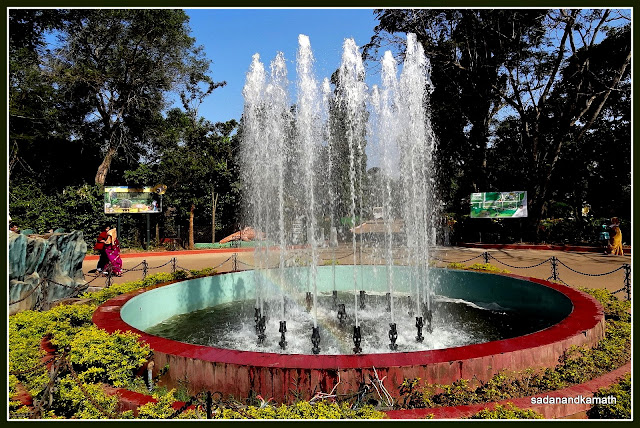 |
| Nandankanan - A fountain on the
junction soon after entering the zoo set the positive mood for the
visitors. |
 |
| Nandankanan - A Battery operated mini
van for those who do not wish to take a long walk to see the zoo animals,
reptiles and birds. This vehicle is specially a boon to senior citizens and
children |
 |
| Nandankanan - Brahminy Kite |
 |
| Nandankanan - Mandarin ducks |
 |
| Nandankanan - Close up of a Painted
Stork. Its beak is so sharp that it can crack bones. |
 |
| Nadankanan - A lone chimpanzee, his mate having left him. |
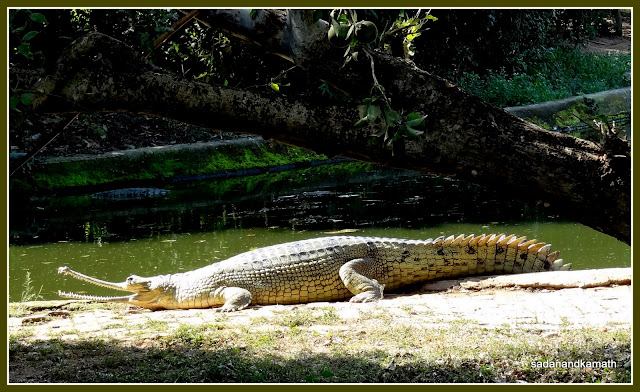 |
| Nandankanan - A gharial is out of the artificial lake to have a 'sun bath' |
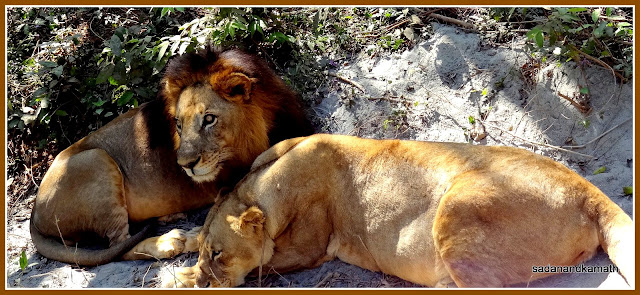 |
| Nandan Kanan - A lion and lioness
resting just outside our Safari bus. |
 |
| NandanKanan - This White tiger refused to give a pose for my camera. |
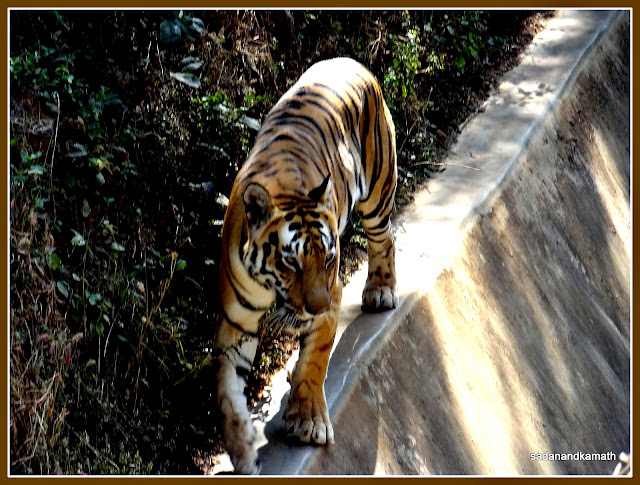 |
| Nandankanan - A tiger on its round |
 |
Nandankanan - Full grown leopard resting on a stone slab inside the enclosure.
|

1 comment:
Post a Comment